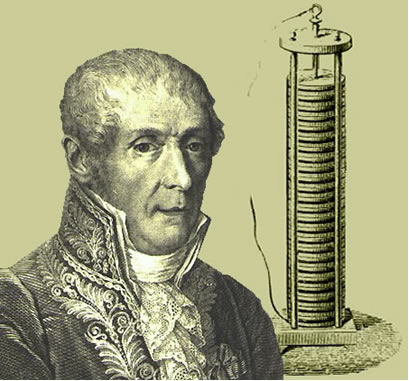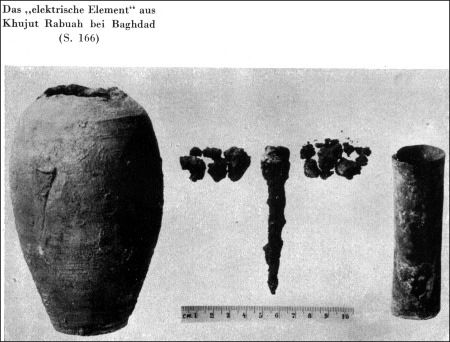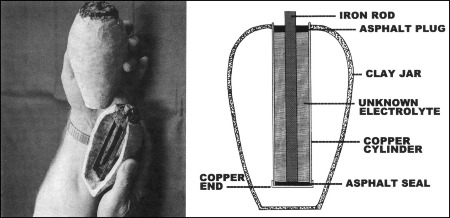Baghdad Battery, First Source of Voltage Storage
Modern day battery technology origins back to 1799 when Alessandro Volta an Italian physicist is credited with its invention. He took two different types of metals, one zinc the other silver and after many experiments determined; By putting a zinc disc down then a silver disc then a disc of damp cardboard made with crude electrolyte, repeated, created enough of a voltage to give the scientist an electric shock. Volta’s electric pile was the first device able to create a consistent source of stored electricity.
But was it the first battery? And even though he was a brilliant inventer, should he be credited with the discovery of the battery?
Enter the Baghdad Battery
Nestled in the National Museum of Iraq are twelve earthenware jars a little larger than an average man’s fist. Originally found in 1936 at Khuyut Rabu, 30 km to the SE of Baghdad, Iraq, the person who made the discovery is not documented. The jar showed signs of corrosion, and early tests revealed that an acidic agent, such as vinegar or wine had been present.
In 1938 Wilhelm Konig, the German director of the National Museum of Iraq, found the jars in the museum’s collections. In 1940, Konig published a paper speculating that they may have been galvanic cells, (batteries) perhaps used for electroplating gold onto silver objects.
The jars date back to around 200 BC – in the Parthian era, circa 250 BC to AD 225. The Parthians were not noted for their scientific achievements so most researchers believe the technology was given to them. The jars are made of an earthenware shell, with a asphalt-type material for a stopper. Sticking through the top of the stopper is an iron rod and inside the jar the rod is surrounded by a cylinder of copper.
All twelve of the jars have the same design:
– Pot: 14cm high with largest diameter of 8cm and a 3.3cm diameter circular top opening.
– Inside: High purity copper cylinder of 10cm height and 2.6cm diameter. The lower end of the copper cylinder is closed with a round, crimped-on, piece of sheet copper that is covered with a 3mm thick layer of asphalt material. The upper end of the cylinder is closed by a thick heavy plug of the same type of asphalt material.
– Inside: Also inside is a solid rod of iron, 7.5cm by 1cm in diameter, which forms the center of the plug and extends down in the copper cylinder.
Making an electric current requires two types of metals with different electrical properties and an ion carrying solution known as electrolyte to transfer the electrons between the two metals.
If you fill the jar with an acidic liquid, such as vinegar or fermented grape juice, then a measurable current voltage can be recorded. Experiments with models have generated between 1.5 and 2 volts. If you connect the jars together in a series connection, then a larger voltage can be created.
Note: Similar objects, less complete (no iron rods) but with copper wires were found nearby at Tel’Omar/Seleukia/Ktesiphon.
Electric Cars:
An all-electric car needs hundreds of volts to operate. Example: If you take 300 single cell batteries of 3 volts each and add them together in series, which means attaching the negative electrode of one cell to the positive electrode of the next, adds up to 300 volts. That’s a lot of voltage.
Tesla Model S all-electric automobile:
The battery pack for the Model S is a 85kWh, 400 volt DC. It uses a cluster of lithium-ion 18650 batteries similar to ones that power laptops. Each battery in the cluster is around 3.6 volts per cell. A battery pack for the Model S uses over 7000 battery cells to get the desired voltage and amperage needed to run their vehicle. This battery pack holds enough energy to provide a U.S. household with electrical needs for almost three days before charging! And that’s a whole lot of voltage!
Now take the Baghdad battery. Twelve were found and experimental models showed each one could generate a voltage of 1.5 to 2 volts. Using the lower voltage 1.5v which is the same as an AA common battery, take twelve Baghdad jars connect them in series, and you get 18 volts. Not too bad now. How about clustering more? 24 jars, 36 volts, 800 jars, 1200 volts! Now we’re getting somewhere. 🙂
Did someone invent or was someone given a AA battery 2000 years ago for some specific need? If you were a time traveler, let’s say Emmett Brown “Doc”, from the movie ‘Back to the Future’ and you were time shifted back 2000 years, obviously certain manufactured materials we use now, alloys and such, would be unavailable. But if you used what was available in that time era, let’s say copper and iron which is indigenous to this planet, and clay-like containers made by the locals, then added them all together with some grape juice, you would get a nifty battery to help you get “Back to the Future”.
The mystery of the Baghdad batteries is; Who or whom is responsible for them? There’s not enough clear data at this time why they exist and who is responsible for their existence. Did a time traveler need some help and left his/her prototypes or technology for the people of that time? Did a space traveler give a technology nudge to a specific group of villagers who later lost that knowledge through attrition? Or, did humans 2000 years ago figure out electroplating techniques for jewelery and such, then somewhere throughout history, specific knowledge was lost? Hard to say, but one thing you can’t deny, the Baghdad battery was first, and it works!
References:
– Wikipedia
– museumgeek.org
– unmuseum.org
– BBC article: Riddle of ‘Baghdad’s batteries’
– Battery University
Category: Chuck Zukowski, The Z-Files












